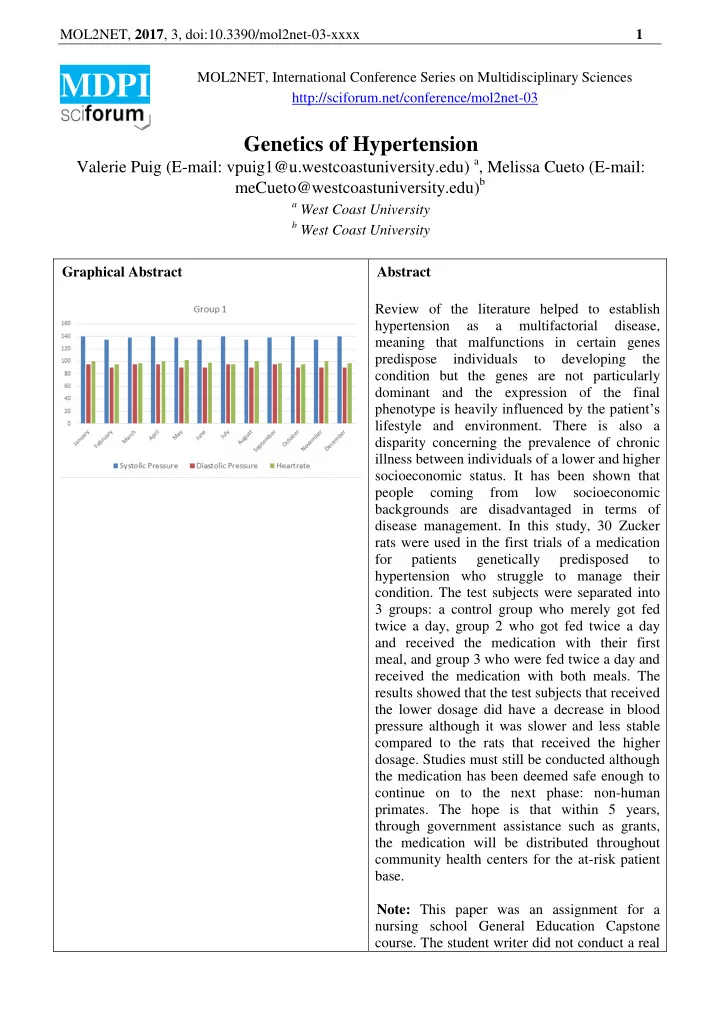

MOL2NET, 2017 , 3, doi:10.3390/mol2net-03-xxxx 1 MOL2NET, International Conference Series on Multidisciplinary Sciences MDPI http://sciforum.net/conference/mol2net-03 Genetics of Hypertension Valerie Puig (E-mail: vpuig1@u.westcoastuniversity.edu) a , Melissa Cueto (E-mail: meCueto@westcoastuniversity.edu) b a West Coast University b West Coast University Graphical Abstract Abstract Review of the literature helped to establish hypertension as a multifactorial disease, meaning that malfunctions in certain genes predispose individuals to developing the condition but the genes are not particularly dominant and the expression of the final phenotype is heavily influenced by the patient’s lifestyle and environment. There is also a disparity concerning the prevalence of chronic illness between individuals of a lower and higher socioeconomic status. It has been shown that people coming from low socioeconomic backgrounds are disadvantaged in terms of disease management. In this study, 30 Zucker rats were used in the first trials of a medication for patients genetically predisposed to hypertension who struggle to manage their condition. The test subjects were separated into 3 groups: a control group who merely got fed twice a day, group 2 who got fed twice a day and received the medication with their first meal, and group 3 who were fed twice a day and received the medication with both meals. The results showed that the test subjects that received the lower dosage did have a decrease in blood pressure although it was slower and less stable compared to the rats that received the higher dosage. Studies must still be conducted although the medication has been deemed safe enough to continue on to the next phase: non-human primates. The hope is that within 5 years, through government assistance such as grants, the medication will be distributed throughout community health centers for the at-risk patient base. Note: This paper was an assignment for a nursing school General Education Capstone course. The student writer did not conduct a real
MOL2NET, 2017 , 3, doi:10.3390/mol2net-03-xxxx 2 study; she rather simulated a study to demonstrate writing/research skills, creativity, scientific knowledge, and an understanding of how to generate and analyze data. The corresponding author is the student’s instructor, who guided the student on each section of the scientific paper, providing feedback on how to “conduct” the study and on how to revis e the writing. Introduction Literature Review: Scientific It is essential to understand the basis of inheriting genetic disorders in order to understand the genetic foundation of an illness such as hypertension. According to Coy (2005), there are four types of genetic disorders: single-gene, chromosomal, mitochondrial, and multifactorial. Single-gene disorders occur due to mutations in the DNA sequence on one particular gene versus chromosomal diseases which originate from a mutation in the structure of a chromosome such as deletion or copy of a particular gene (Coy, 2005). A defect or mutation in mitochondrial DNA, inherited solely from the patient’s maternal DNA, can result in a mitochondrial disease (Coy, 2005). Hypertension is a multifactorial disease because although individuals may present with malfunctions in several genes, neither gene malfunction is particularly dominant and the patient’s lifestyle and environment play an important role in producing the final phenotype (Coy, 2005). This being said, there have been rare presentations of Mendelian forms of hypertension; where a single gene mutation results in deviations of blood pressure (Singh et al., 2016). Blood pressure is defined as the force of blood as it pushes against the walls of the arteries when the ventricles of the heart contract (National Heart, Lung, and Blood Institute, 2015). There are two readings seen when noting a patient’s blood pressure, the systolic and diastolic pressure. Systolic pressure is the pressure of blood against arterial walls when the heart is contracting while diastolic is the pressure when the heart is at rest in between beats (National Heart, Lung, and Blood Institute, 2015). The National Heart, Lung, and Blood Institute (2015) denotes that high blood pressure, also known as hypertension, is a blood pressure reading of 140/90mmHg and above. This same article mentions that there are two main types or stages of high blood pressure: primary, or essential, which is the type that generally develops over time as a person ages. A study done by Marrie et al. (2012) reinforced that the risk associated with developing hypertension increased with age. There is also secondary high blood pressure which is caused by a separate medical condition or a particular medication; this type can be easier to treat as it will generally be resolved once its causative agent has been treated or removed (National Heart, Lung, and Blood Institute, 2015). There are several genes that are considered in the synergistic association between genetics of hypertension and external environmental factors (Sousa et al., 2017). The angiotensinogen gene is responsible for coding for the substrate renin, indirectly responsible in lowering blood pressure (Singh et al., 2016). There are two genes that are considered as relatively similar and mutations in them could have the same effect: the angiotensin-converting enzyme gene and the renin gene (Singh et al., 2016). A silent mutation can exist on the angiotensin II receptor type I gene which promotes vasoconstriction and growth that provides for an especially aggressive form of essential hypertension (Singh et al., 2016). A polymorphism of the gene responsible for producing G-proteins was linked to lower levels of renin and prorenin, dually responsible for lowering blood pressure in normal healthy individuals (Singh et al., 2016) A population study revealed that polymorphisms of cystathionine β -synthase resulted in a higher risk factor for developing essential hypertension (Ying et al., 2014). Mutations in the adducin gene can provide another risk factor for persons who contain the mutation in their DNA as alterations in the gene have been shown to affect tubular sodium reabsorption (Singh et al., 2016). In
Recommend
More recommend